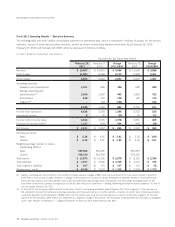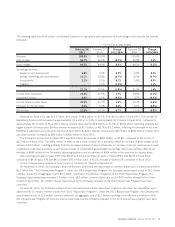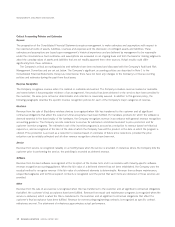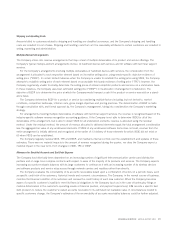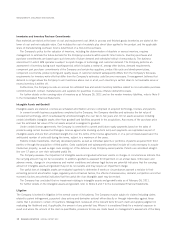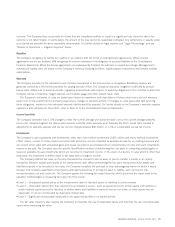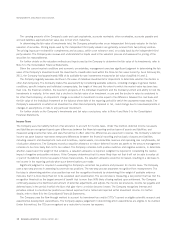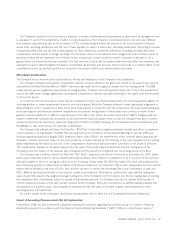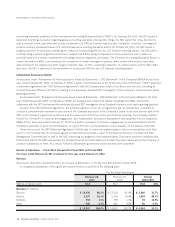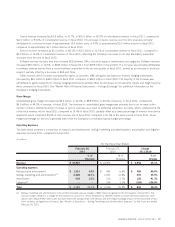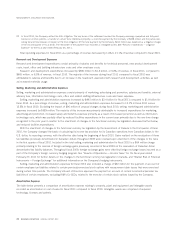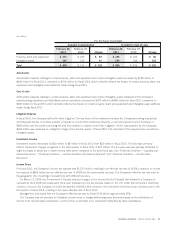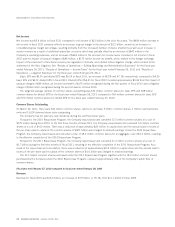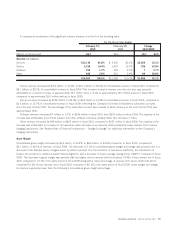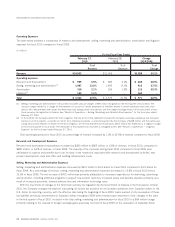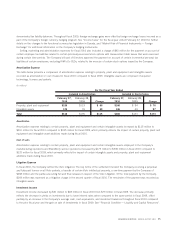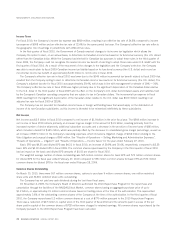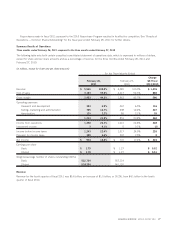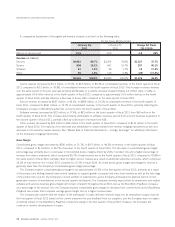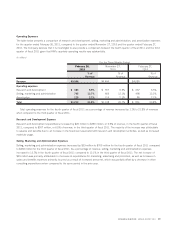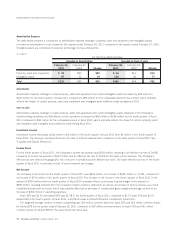Blackberry 2011 Annual Report Download - page 33
Download and view the complete annual report
Please find page 33 of the 2011 Blackberry annual report below. You can navigate through the pages in the report by either clicking on the pages listed below, or by using the keyword search tool below to find specific information within the annual report.(2) In fiscal 2010, the Company settled the Visto Litigation. The key terms of the settlement involved the Company receiving a perpetual and fully-paid
license on all Visto patents, a transfer of certain Visto intellectual property, a one-time payment by the Company of $268 million and the parties exe-
cuting full and final releases in respect of the Visto Litigation. Of the total payment by the Company, $164 million was expensed as a litigation charge
in the second quarter of fiscal 2010. The remainder of the payment was recorded as intangible assets. See “Results of Operations — Litigation
Expense” for the fiscal year ended February 26, 2011.
Total operating expenses for fiscal 2011 as a percentage of revenue decreased by 1.4% to 21.1% of revenue compared to fiscal 2010.
Research and Development Expenses
Research and development expenditures consist primarily of salaries and benefits for technical personnel, new product development
costs, travel, office and building infrastructure costs and other employee costs.
Research and development expenditures increased by $386 million to $1.4 billion, or 6.8% of revenue, in fiscal 2011, compared to
$965 million, or 6.5% of revenue, in fiscal 2010. The majority of the increase during fiscal 2011 compared to fiscal 2010 was
attributable to salaries and benefits due to an increase in the headcount associated with research and development activities, as well
as increased materials usage.
Selling, Marketing and Administration Expenses
Selling, marketing and administration expenses consist primarily of marketing, advertising and promotion, salaries and benefits, external
advisory fees, information technology costs, office and related staffing infrastructure costs and travel expenses.
Selling, marketing and administration expenses increased by $493 million to $2.4 billion for fiscal 2011 compared to $1.9 billion for
fiscal 2010. As a percentage of revenue, selling, marketing and administration expenses decreased to 12.1% in fiscal 2011 versus
12.8% in fiscal 2010. Excluding the impact of $96 million of unusual charges during fiscal 2010, selling, marketing and administration
expenses increased by $589 million. The majority of this increase was primarily attributable to increased expenditures for marketing,
advertising and promotion, increased salary and benefits expenses primarily as a result of increased personnel as well as information
technology costs, which was partially offset by reduced facilities expenditures in the current year primarily due to the one-time charge
recognized in the prior year in relation to the enactment of changes to the functional currency tax legislation discussed further below,
and reduced facilities expenditures.
With the enactment of changes to the functional currency tax legislation by the Government of Canada in the first quarter of fiscal
2010, the Company changed the basis of calculating its income tax provision for its Canadian operations from Canadian dollars to the
U.S. dollar, its reporting currency, with the effective date being the beginning of fiscal 2010. Gains realized on the revaluation of these
tax liabilities previously denominated in Canadian dollars throughout 2009 were reversed upon enactment of the changes to the rules
in the first quarter of fiscal 2010. Included in the total selling, marketing and administration for fiscal 2010 is a $54 million charge
primarily relating to the reversal of foreign exchange gains previously recorded in fiscal 2009 on the revaluation of Canadian dollar
denominated tax liability balances. Throughout fiscal 2009, foreign exchange gains were offset by foreign exchange losses incurred as a
part of the Company’s foreign currency hedging program. See “Results of Operations — Income Taxes” for the fiscal year ended
February 27, 2011 for further details on the changes to the functional currency tax legislation in Canada, and “Market Risk of Financial
Instruments — Foreign Exchange” for additional information on the Company’s hedging instruments.
Selling, marketing and administration expenses for fiscal 2010 also included a charge of $42 million for the payment on account of
certain employee tax liabilities related to certain previously-exercised stock options with measurement date issues that were exercised
during certain time periods. The Company’s Board of Directors approved the payment on account of certain incremental personal tax
liabilities of certain employees, excluding RIM’s Co-CEOs, related to the exercise of certain stock options issued by the Company.
Amortization Expense
The table below presents a comparison of amortization expense relating to property, plant and equipment and intangible assets
recorded as amortization or cost of sales for fiscal 2011 compared to fiscal 2010. Intangible assets are comprised of acquired
technology, licenses and patents.
20 RESEARCH IN MOTION ANNUAL REPORT 2011
MANAGEMENT’S DISCUSSION AND ANALYSIS


